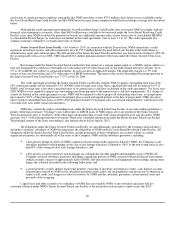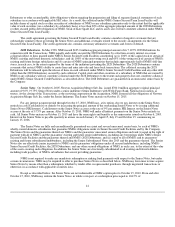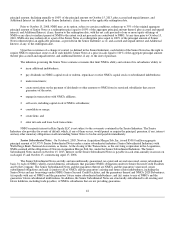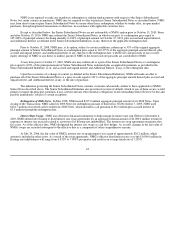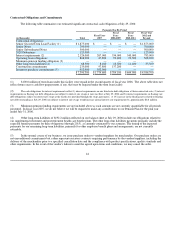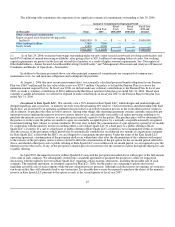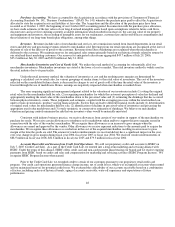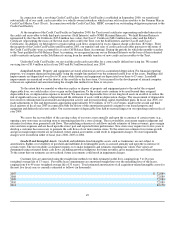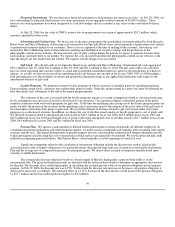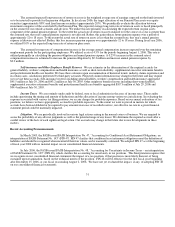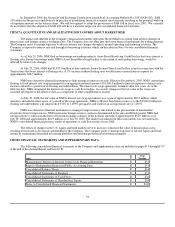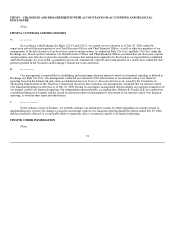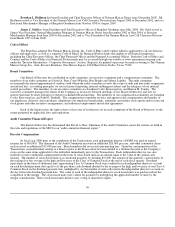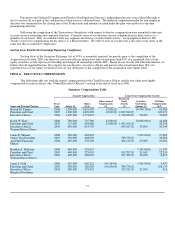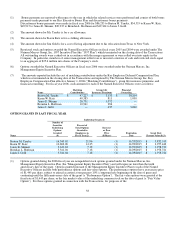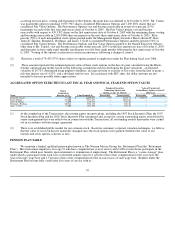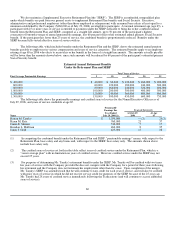Neiman Marcus 2005 Annual Report Download - page 54
Download and view the complete annual report
Please find page 54 of the 2005 Neiman Marcus annual report below. You can navigate through the pages in the report by either clicking on the pages listed below, or by using the keyword search tool below to find specific information within the annual report.
Financial Instruments. We use derivative financial instruments to help manage our interest rate risks. At July 29, 2006, we
have outstanding floating and fixed interest rate swap agreements for an aggregate notional amount of $1,000.0 million. These
interest rate swap agreements have been designated as cash flow hedges and are recorded at fair value on the consolidated balance
sheets.
At July 29, 2006, the fair value of NMG's interest rate swap agreements was a gain of approximately $20.2 million, which
amount is included in other assets.
Advertising and Catalog Costs. We incur costs to advertise and promote the merchandise assortment offered by both Specialty
Retail stores and Direct Marketing. Advertising costs incurred by our Specialty Retail stores consist primarily of print media costs related
to promotional materials mailed to our customers. These costs are expensed at the time of mailing to the customer. Advertising costs
incurred by Direct Marketing relate to the production, printing and distribution of our print catalogs and the production of the
photographic content on our websites. We amortize the costs of print catalogs during the periods we expect to generate revenues from
such catalogs, generally three to six months. We expense the costs incurred to produce the photographic content on our websites at the
time the images are first loaded onto the website. We expense website design costs as incurred.
Gift Cards. We sell gift cards at our Specialty Retail stores and through Direct Marketing. Unredeemed gift cards aggregated
$30.1 million at July 29, 2006, $25.6 million at July 30, 2005 and $21.8 million at July 31, 2004. The gift cards sold to our customers
have no stated expiration dates and are subject to actual and /or potential escheatment rights in various of the jurisdictions in which we
operate. As a result, we have not reversed any unredeemed gift card balances into income in fiscal years 2006, 2005 or 2004 pending a
final determination as to the invalidity of current and potential escheatment claims in any applicable jurisdictions with respect to the
unredeemed balances of gift cards.
Loyalty Programs. We maintain customer loyalty programs in which customers accumulate points for qualifying purchases.
Upon reaching certain levels, customers may redeem their points for gifts. Generally, points earned in a given year must be redeemed no
later than ninety days subsequent to the end of the annual program period.
The estimates of the costs associated with the loyalty programs require us to make assumptions related to customer purchasing
levels, redemption rates and costs of awards to be chosen by our customers. Our customers redeem a substantial portion of the points
earned in connection with our loyalty programs for gift cards. At the time the qualifying sales giving rise to the loyalty program points are
made, we defer the portion of the revenues on the qualifying sales transactions equal to the estimate of the retail value of the gift cards to
be issued upon conversion of the points to gift cards. We record the deferral of revenues related to gift card awards under our loyalty
programs as a reduction of revenues. In addition, we charge the cost of all other awards under our loyalty programs to cost of goods sold.
We deferred revenues related to anticipated gift card awards of $28.5 million in fiscal year 2006, $23.8 million in fiscal year 2005 and
$20.8 million in fiscal year 2004 and charged costs of goods sold for the anticipated costs of all other awards of $3.7 million in fiscal year
2006, $4.9 million in fiscal year 2005 and $6.1 million in fiscal year 2004.
Pension Plan. We sponsor a noncontributory defined benefit pension plan covering substantially all full-time employees. In
calculating our pension obligations and related pension expense, we make various assumptions and estimates after consulting with outside
actuaries and advisors. The annual determination of pension expense involves calculating the estimated total benefits ultimately payable
to plan participants and allocating this cost to the periods in which services are expected to be rendered. We use the projected unit credit
method in recognizing pension liabilities. The Pension Plan is valued annually as of the beginning of each fiscal year.
Significant assumptions related to the calculation of our pension obligation include the discount rate used to calculate the
actuarial present value of benefit obligations to be paid in the future, the expected long-term rate of return on assets held by the Pension
Plan and the average rate of compensation increase by plan participants. We review these actuarial assumptions annually based upon
currently available information.
The assumed discount rate utilized is based on a broad sample of Moody's high quality corporate bond yields as of the
measurement date. The projected benefit payments are matched with the yields on these bonds to determine an appropriate discount rate
for the plan. The discount rate is utilized principally in calculating the actuarial present value of our pension obligation and net pension
expense. At July 29, 2006, the discount rate was 6.25%. To the extent the discount rate increases or decreases, our pension obligation is
decreased or increased, accordingly. The estimated effect of a 0.25% decrease in the discount rate would increase the pension obligation
by $15.7 million and increase annual pension expense by $0.9 million.
50


